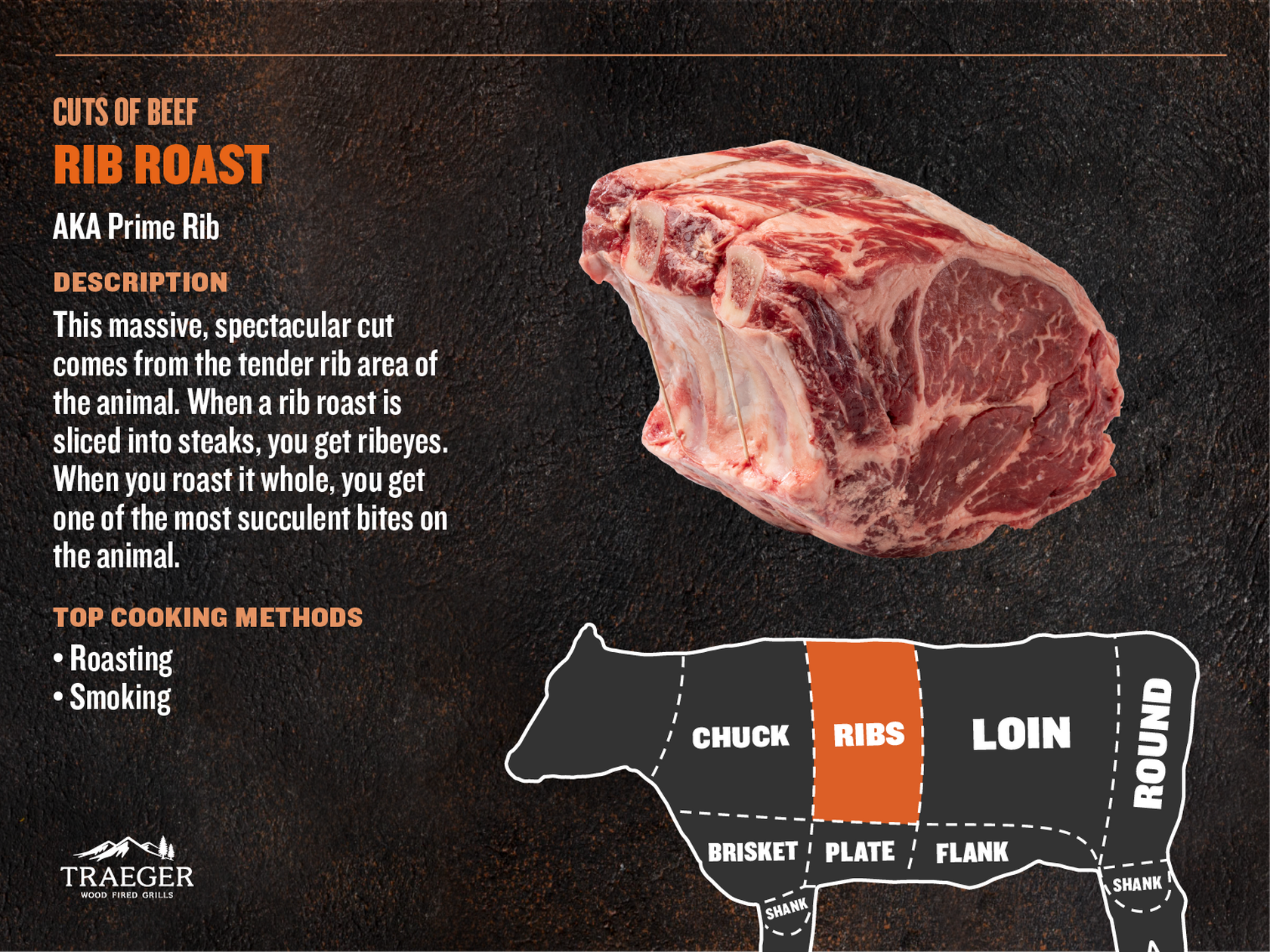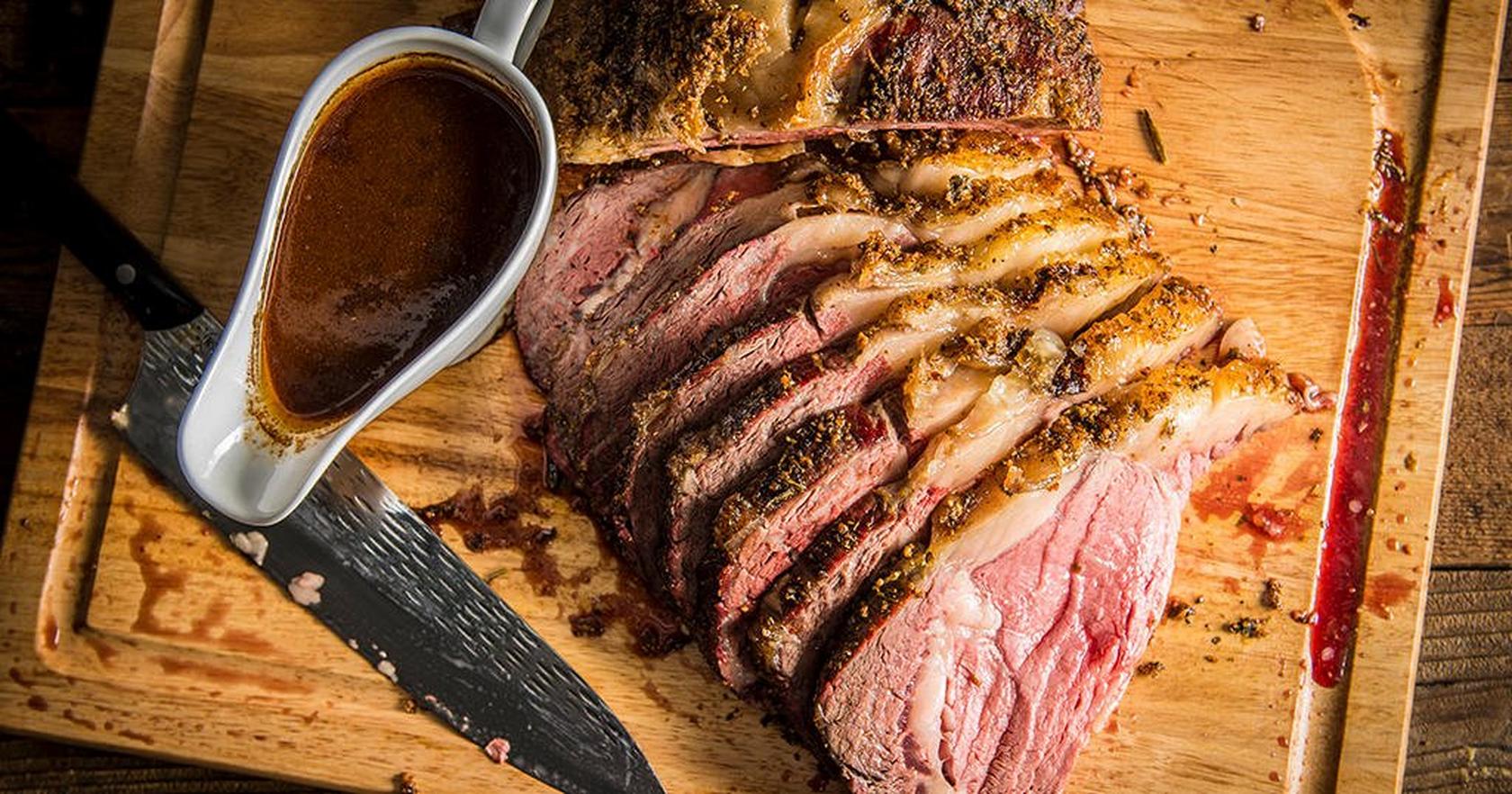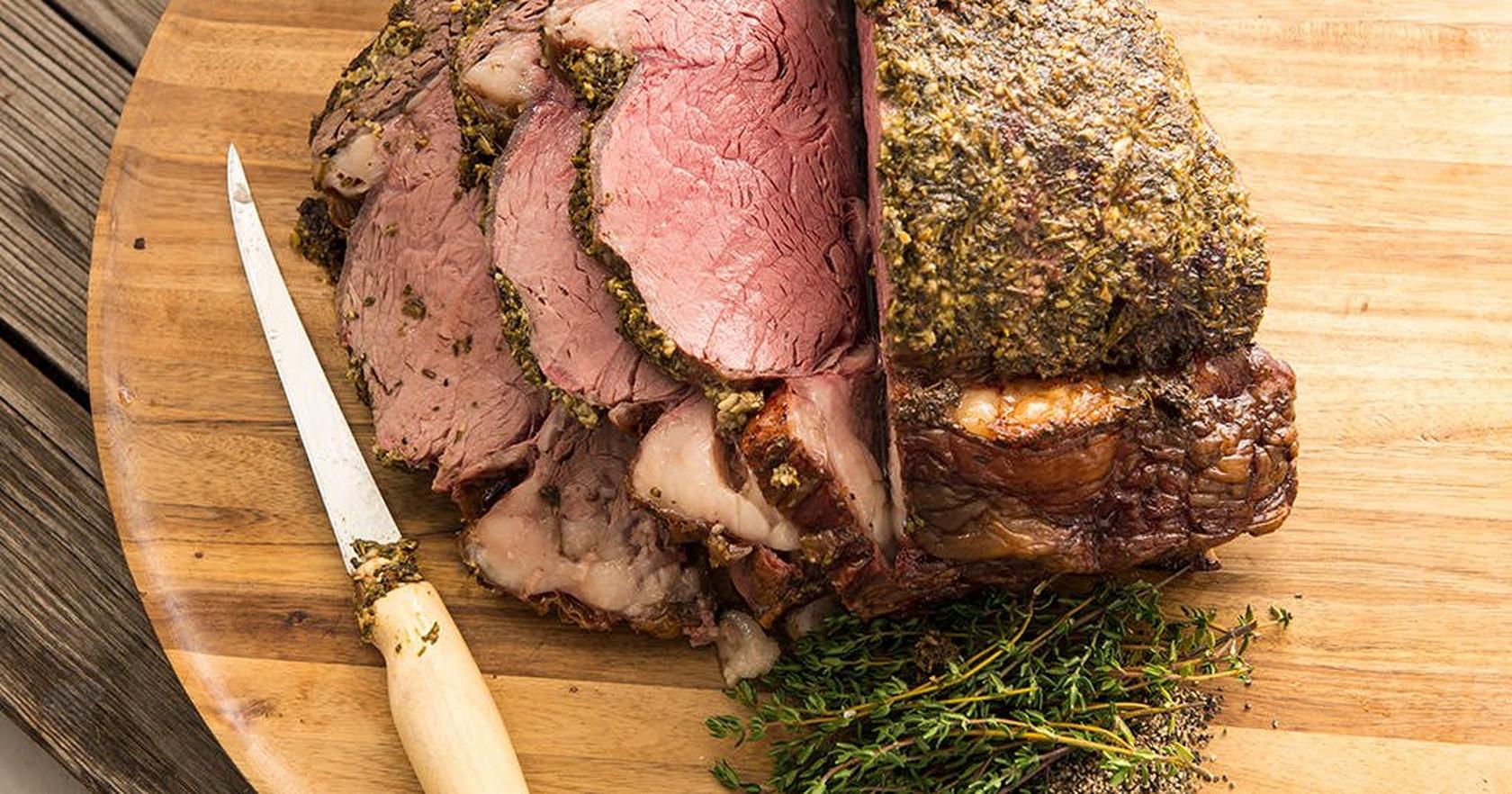
When the occasional calls for a special main course, few foods fit the bill as well as a standing rib roast. What exactly is a standing rib roast? Also called a prime rib roast or just prime rib, a beef prime rib roast is comprised of the large round of meat and usually the bones cut from ribs 6 through 12 on a cow. These large cuts look impressive whole, and the large slices of tender meat look great on the plate. They also have a great beefy flavor, which makes sense because when this cut is sliced into steaks before cooking, it’s known as ribeye.
What follows include tips on buying, flavoring, cooking, and carving your roast. However, if you just want to skip to the recipes, go ahead and peruse out top 10 recipes for standing rib roast.
How To Shop For A Standing Rib Roast
Though available year-round, you will see more standing rib roasts at the supermarket around the holidays. The largest of these roasts have all seven ribs and can weigh as much as 20 pounds. However, unless you are having a huge gathering, a partial rack such as 3- to 4-bone rib roast likely makes more sense as a 4-bone standing rib roast will easily feed eight people.
Buy the highest grade you can afford. Contrary to how it may sound, prime rib does not mean prime grade, prime being the highest grade given to meat by the United States Department of Agriculture (USDA). The grade is based on the amount of intra muscular fat (aka marbling). If you can find prime, you are lucky as only a very small percentage of meat in the U.S. gets this rating. (It will also cost a small fortune, but many find it worth the splurge.) Choice and Select come next, and you can find Choice at most supermarkets. Bear in mind that getting such a rating is voluntary and so you may find that a local farm has an unrated roast that will cook up deliciously.
Which ribs to buy? You may have the option to select which ribs your roast will contain. Why is this important? Ribs 6 through 9 are closer the shoulder and will contain large amounts of fat while ribs 10 through 12, known as the first cut, are learner. Some prefer the beefier flavor from the former while others prefer the tenderness of the latter. The choice, if available, is yours.
Ensure the chine bone has been removed. Most butchers will remove the chine bone, sometimes referred to as the backbone, from the roast. But double check as removing it requires a saw. You can still cook a standing rib roast with the chine bone attached, but carving it is difficult.
Bone-in or boneless? Standing rib roasts are available with the ribs intact or boneless. Whether bones add flavor to the meat during cooking is up for debate, but there’s no doubt they insulate the meat and help keep it from drying out. (And the cooked rib bones, with their crisp, fatty bits are a treat for the cook, perfect for nibbling.) The downside? Bones make carving trickier. Keep reading to see how to get the best of both worlds.
Frenched or not? A Frenched bone is one that has had the meat and sinew scraped away. Some believe it makes the roast look fancier. You can ask the butcher to French the bones or you can do it yourself. However, you lose out on some great meaty rib nibbling by doing so. (Find more on Frenching here.)

Tips For Cooking A Standing Rib Roast
Cooking a standing rib roast is not difficult per se, but it’s such a pricey cut of meat, that you want to be sure to do it right. For most, that means cooked to a perfect medium-rare all the way through. What follows are some tips to guarantee your roast turns out tender and juicy. You don’t have to follow all of them; pick and choose which might work best for you.
Salt the meat well ahead. For the best flavor, salt the roast all over at least 24 hours before cooking it. This pre-salting, also known as a dry brine, concentrates the meat’s flavor making it taste, well, beefier.
Cut the ribs off—then tie them back on! As already mentioned, the bones help keep the meat tender and juicy while it cooks. They also make a natural rack for the eye of beef above them. But then you need to cut the bones off after cooking to carve (which is always an option). To make it even easier, however, you can cut the rib plate off in one piece (it’s easier than it sounds) and tie it back on for roasting. This way, you can easily remove the ribs come carving time.
To slice off the rib plate, hold a long sharp knife held parallel to the rib bones. Slice between the meat and bones, following the inner curve of the bones. Remove the bone plate from the roast in one piece with the bones attached. Before tying it back on, season both the rib plate and the meat with whatever rub or herbs you plan to use for the roast. Once seasoned, tie the plate back onto the roast using 3 or 4 lengths of butcher’s twine.
Coat the roast with mayo. The secret is out: Slathering mayonnaise on a roast, whether turkey or beef, makes it cook up incredibly moist, tender, and beautifully browned. If you’re not a fan of mayonnaise, fear not: You won’t taste it. See how it’s done in this foolproof recipe.
Season the roast. Though a smidge of black pepper along with the pre-salting can be enough, you may want to add a spice rub as well. Call us partial, but we really like our Traeger Prime Rib Rub. Not only does it add a hint of garlic and rosemary, but it also encourages browning. Chopped fresh herbs are also welcome and help encourage a flavorful crust.

Cook it low and slow. To ensure medium-rare slices from edge to edge, skip the searing and cook the roast on your Traeger pellet grill low and slow, around 250°F works well. Because the internal temperature rises slowly and steadily, there’s much less risk of overcooking the meat. You can cook the meat directly on the grill grates, which allows for optimum smoke flavor, or in a roasting pan, which is useful if you plan to make a sauce with the meat’s dripping.
As for pellets, you can add more wood-fired flavor by using a strong wood like hickory or mesquite. For milder smoke flavor, look to apple or cherry. Our Steak Blend pellets are on the bold side as well, and they come with a rub and chimichurri mix that would both go well on a standing rib roast.
Use a leave-in thermometer to gauge doneness. With a giant roast there is simply no other way to check for doneness than with a meat thermometer. We strongly suggest using a leave-in thermometer, such as a MEATER®. This way you are only poking the roast once instead of multiple times and losing precious juices with each poke. It also means you don’t have to lift the grill lid every time to check.
You want to insert the thermometer so that its tip is in the thickest part of the roast away from the bones. For medium rare, take the roast off the grill when it’s between 125°F and 130°F.
What To Do With Your Roast
There are a few things you will need to do once you take the meat off the heat to guarantee success: rest it, learn how to carve a standing rib roast, and, optionally, make an au jus to go with it.
Let the meat rest before carving. A rest after cooking is important for all large cuts of meat to guarantee the meat is tender and juicy. At the start of the rest, the meat is still cooking, rising another 5 to 10 degrees. As the meat sits, the juices inside the roast that have risen to the top have time to redistribute. You want to give a large roast at least 20 to 30 minutes rest time before carving.
Serve with a flavorful au jus. As the meat roasts, any seasoning or vegetables you may have added to the roasting pan conspire with the meat’s juices as the start of an exquisite pan sauce (what the French call au jus). All you need to do is add some more liquid to the roasting in the form of broth and then strain it to serve.
Or go with a sauce. While no one would complain if their prime rib came sauceless, there are all kinds of sauces that work well with the meat. A creamy horseradish sauce is classic, but an herby chimichurri or salsa verde would also add punchy flavor.

How To Carve A Standing Rib Roast
Unlike, say, carving a turkey, it's easy to learn how to carve a standing rib roast. Unless you have a cutting board with a very deep trough, safe yourself some grief and place your cutting board inside a rimmed baking sheet so any juices are contained there a not spilling out on your counter.
Remove the bones from the meat. If the ribs are still attached to the roast, you will need to cut them off. To do that easily, stand the roast up so that the the tips of the rib bones are facing the ceiling, Use a sharp knife to cut down close to the bones to remove them all in one piece from the meat. (If you have cut the bones off before cooking and tied them back on, simply, cut the strings and remove the twine and bones form the meat.) The bones are great to nibble on and you can separate them and place them in your platter along with the sliced meat. Or use them to make soup. Just don’t give them to your dog because they can splinter.
Slice the meat in the direction of the bones. Place the meat on its cut side (where the ribs were). Use your longest sharpest knife to cut the slices form this big hunk of meat. Traditionally, prime rib is sliced about ½ inch chick, but you can go a little thinner or thicker depending on your preference. Only slice as much as you are serving right away; the meat will hold better in a larger piece.

What To Do With Leftover Standing Rib Roast
If you are lucky, there will be a little rib roast leftover for sandwiches. To store the meat, wait till it’s cooled then wrap it in plastic wrap and place it on a plate in case any juices lea. Refrigerate the meat for up to 5 days and use it to make your favorite beef sandwiches, such as this Italian Beef Sandwich or a French dip. You can also add cut up prime rib to your favorite soups, curries, or quesadillas.
Smoked RibEye Roast
by Traeger Kitchen
33 Reviews
Prep Time
15 Min
Cook Time
4 Hr
Serves
6
Pellets
Hickory
Gather your crew for a richly flavored Sunday dinner. Smoked rib eye roast cooked low and slow on the wood-fired grill is a game changer when covered with mustard, Worcestershire sauce, garlic, and our Traeger Prime Rib Rub.
Ingredients
main
| 1 | (4-6 lb) rib-eye roast |
| 4 Tablespoon | yellow mustard |
| 1 Tablespoon | Worcestershire sauce |
| 1 Clove | garlic, minced |
| To Taste | Traeger Prime Rib Rub |
| 4 Sprig | fresh thyme |
1
When ready to cook, set the Traeger temperature to 250℉ and preheat with the lid closed for 15 minutes.
2
While the Traeger is preheating, prepare the roast: Trim any excess fat from the top of the roast down to 1/4 inch thick.
3
In a small bowl, combine the mustard, Worcestershire sauce, and garlic. Cover the entire roast with the mustard mixture and season liberally with Traeger Prime Rib Rub.
4
Lay the thyme sprigs on the top of the roast.
5
Insert the probe into the center of the roast, avoiding the bones and any large pockets of fat. Place the roast directly on the grill grates, close the lid, and smoke until the internal temperature of the roast reaches 135℉ for rare or 145℉ for medium, 3-4 hours.
6
Remove the roast from grill. Tent with foil and let rest for 20 minutes before carving. Enjoy!